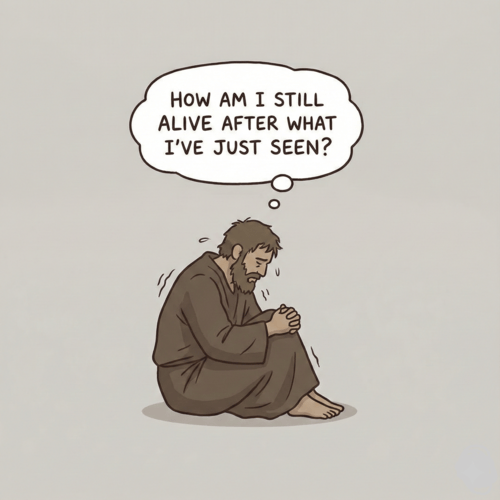Caught in Adultery: How Reliable Is the John 8 Story?
“Let him who is without sin cast the first stone.”
Few Bible scenes capture Jesus’ wisdom and grace quite like that of the woman caught in adultery. But this beloved story from John 8:1-11 faces serious questions. Critics claim it’s missing from the oldest manuscripts, that the details don’t add up, and that it was likely invented by medieval scribes.
Should these objections shake our confidence in this powerful account? Let’s examine each major criticism and provide solid answers.
OBJECTION 1: “IT’S MISSING FROM THE OLDEST MANUSCRIPTS”
The Claim: The story doesn’t appear in our earliest Bible manuscripts—Papyrus 66, Papyrus 75, Codex Sinaiticus, and Codex Vaticanus. If it were original, it would be there.
Our Answer: This objection misunderstands how biblical authority works. God’s inspiration applied to the original texts written by the apostles, not to every manuscript copy made by human scribes centuries later. The authority of Scripture rests in divine authorship, not in the perfection of manuscript transmission.
Consider this: when copyist errors occur elsewhere in manuscripts, we don’t conclude those passages lack divine authority—we work to determine the original reading. The same principle applies here. The absence from early manuscripts tells us about the copying process, not about the story’s authenticity or spiritual value.
Moreover, the passage appears in later manuscripts and was eventually embraced by the broader church. Church fathers like Augustine knew and referenced the account. This suggests the story circulated in authentic Christian tradition, even if it wasn’t initially part of John’s written Gospel.
OBJECTION 2: “WHERE’S THE MAN? JEWISH LAW REQUIRED BOTH PARTIES”
The Claim: If the woman was “caught in adultery,” where’s the man? Jewish law demanded both parties be brought for judgement. Doesn’t the man’s absence in the narrative prove the story is fictional?
Our Answer: This objection actually supports the story’s authenticity by revealing the corrupt setup Jesus faced. The Pharisees weren’t interested in justice—they were laying a trap. They deliberately violated proper legal procedure to create a dilemma for Jesus.
Here’s the historical context: Under Roman occupation, Jewish religious leaders had limited authority to carry out death sentences. They needed to either get Roman approval or find ways around Roman law. By bringing only the woman, they revealed their true agenda: not upholding justice, but catching Jesus in a political trap.
If Jesus said “stone her,” He’d violate Roman authority. If He said “let her go,” He’d appear to dismiss Jewish law. Either way, they expected to have him framed. The missing man wasn’t an oversight—it was part of the calculated injustice that Jesus so brilliantly exposed.
The selective prosecution fits perfectly with Jesus’ consistent confrontation of religious hypocrisy throughout the Gospels. The legal irregularity doesn’t undermine the story—it explains why Jesus responded by focusing on the accusers’ own sins rather than the technical details of the case.
OBJECTION 3: “THE WRITING STYLE DOESN’T MATCH JOHN’S GOSPEL”
The Claim: Linguistic analysis shows the passage uses vocabulary and grammar patterns different from the rest of John’s Gospel. This proves it was added later by someone else.
Our Answer: Stylistic differences could indicate several things, not necessarily inauthenticity. The passage may preserve an authentic Jesus tradition that circulated independently before being incorporated into John’s Gospel. Early Christians carefully preserved Jesus’ words and deeds through oral tradition and written collections.
It’s also worth noting that stylistic analysis has limitations. Authors can vary their style for different contexts, audiences, or subject matter. John himself might have incorporated a well-known Jesus tradition that had been preserved in slightly different language patterns.
The content perfectly matches Jesus’ character as portrayed throughout the undisputed parts of John’s Gospel—the wisdom, the grace, the ability to see through religious pretense. Style questions don’t override this fundamental coherence with everything else we know about Jesus.
OBJECTION 4: “MEDIEVAL SCRIBES JUST MADE IT UP”
The Claim: The story was invented by medieval monks who wanted to add a touching tale about forgiveness to the biblical text.
Our Answer: This theory faces serious problems. Medieval scribes saw themselves as preservers, not creators, of sacred text. They were extremely conservative about adding material to Scripture. When they did include additional content, they typically marked it clearly as commentary or explanation.
More importantly, the story contains details that would be unlikely for medieval invention. The specific legal trap, the Roman-Jewish political tensions, the particular form of Jesus’ response—all reflect first-century Palestinian context, not medieval European understanding.
Church fathers from different regions and centuries reference similar traditions about Jesus showing mercy to accused women. This suggests the story has ancient roots in authentic Christian memory, not medieval imagination.
OBJECTION 5: “IT CONTRADICTS JESUS’ OTHER TEACHINGS ABOUT SIN”
The Claim: Jesus tells the woman “go and sin no more” without requiring repentance or confession, which contradicts His other teachings about the need for repentance.
Our Answer: This objection misreads the passage. Jesus’ response actually demonstrates perfect pastoral wisdom. He protects the woman from unjust execution while clearly acknowledging her sin and calling for change.
The phrase “go and sin no more” is itself a call to repentance—just delivered with grace rather than condemnation. Jesus often adapted His approach to each person’s situation. With the self-righteous Pharisees, He was confrontational. With the vulnerable woman, He was protective while still addressing her sin.
This perfectly matches Jesus’ consistent pattern throughout the Gospels: showing special compassion to society’s outcasts while still calling them to holiness. The woman’s willingness to remain and listen to Jesus, rather than fleeing when her accusers left, suggests a heart already moved toward repentance.
WHY THESE OBJECTIONS ACTUALLY SUPPORT THE STORY
Ironically, many of these criticisms actually point toward the account’s authenticity. The legal irregularities reflect real first-century corruption. The complex manuscript history suggests ancient tradition rather than medieval invention. The pastoral nuance matches Jesus’ character perfectly.
If someone were inventing this story, they’d likely create something simpler and less problematic. The fact that the account raises questions while still displaying profound spiritual insight suggests authentic historical memory preserved through the complex process of early Christian tradition.
THE REFORMED PERSPECTIVE: TRUTH AND GRACE
How should believers handle these textual questions? With both scholarly honesty and confident faith.
- First, we acknowledge textual criticism doesn’t threaten biblical authority. God sovereignly preserved His Word through human processes that sometimes involved complex transmission histories. The essential Gospel message remains crystal clear in hundreds of other passages with unquestioned manuscript support.
- Second, whether or not this passage was part of John’s original Gospel, it teaches truths about grace, forgiveness, and Jesus’ character that are abundantly confirmed elsewhere in Scripture. We can appreciate its spiritual value while maintaining scholarly precision about its textual history.
- Third, we recognise God’s providence in how Scripture has been preserved and recognised by the church across centuries. Even if this story entered the biblical text through a complex historical process, it has served to point countless people toward the grace of Christ.
THE WOMAN CAUGHT IN ADULTERY: THE BIG PICTURE
The reliability of this story ultimately doesn’t rest on resolving every critical objection, but on its fundamental coherence with everything else we know about Jesus Christ. The wisdom, the grace, the confrontation of hypocrisy, the protection of the vulnerable—all of this perfectly matches the Jesus we encounter throughout the Gospels.
Whether the story was originally part of John’s Gospel or represents authentic tradition preserved elsewhere, it points us to the same Saviour who said, “I did not come to condemn the world, but to save it” (John 12:47—a verse with unquestioned textual support).
The woman caught in adultery reminds us Jesus came not for the self-righteous, but for sinners who need grace. That Gospel truth stands on the firmest possible foundation, regardless of how we resolve the textual questions surrounding this particular account.
Our confidence rests not in the manuscript history of any single passage, but in the unchanging character of the God who reveals Himself consistently throughout Scripture—the God who shows both perfect justice and perfect mercy, who confronts sin while offering forgiveness to all who come to Him in faith.
CAUGHT IN ADULTERY: RELATED FAQs
What do contemporary Reformed scholars say about this passage? DA Carson acknowledges the textual difficulties but argues the story fits Jesus’ character perfectly and may represent authentic oral tradition preserved outside John’s original Gospel. John Piper takes a similar approach, suggesting we can appreciate the passage’s spiritual value while maintaining scholarly honesty about its textual history. Both emphasise core Christian doctrine doesn’t depend on disputed passages, and textual criticism actually demonstrates the careful preservation of Scripture.
- If the story of the woman caught in adultery wasn’t originally in John, where did it come from? Many scholars believe it represents a genuine historical encounter with Jesus that was preserved in oral tradition or early Christian writings outside the canonical Gospels. The church father Jerome mentioned some manuscripts of his day contained the story in different locations, suggesting it circulated independently before being inserted into John’s Gospel. It may have originated from the same apostolic circles that preserved other authentic Jesus traditions.
- Why would medieval scribes add a story to the Bible if they knew it wasn’t originally there? Medieval scribes likely didn’t see themselves as “adding” material but as preserving authentic Jesus tradition that belonged in Scripture. In an era before printing presses, manuscripts often contained marginal notes with additional stories or explanations. Over time, scribes may have incorporated these notes into the main text, believing they were preserving genuine apostolic tradition rather than creating new content.
How does this affect Bible translations like the ESV or NIV? Most modern translations include the passage of the woman caught in adultery but with brackets or footnotes indicating the textual uncertainty. The ESV includes a note stating “The earliest manuscripts do not include 7:53–8:11.” The NIV similarly brackets the passage with explanatory notes. This approach allows readers to engage with the text while understanding the scholarly consensus about its manuscript history.
- Are there other significant passages in the New Testament with similar textual questions? Yes, the longer ending of Mark (16:9-20) and the Trinitarian formula in 1 John 5:7-8 face similar textual challenges. However, these represent a tiny fraction of the New Testament text. Scholars estimate over 99% of the New Testament text is certain, and textual variants affecting major doctrines are extremely rare.
- What’s the difference between this and the “lost gospels” that skeptics sometimes mention? The woman caught in adultery appears in actual biblical manuscripts and was recognized by the historic church, unlike the much later Gnostic writings often called “lost gospels.” While the passage has textual questions, it reflects orthodox Christian teaching and may preserve authentic apostolic tradition. The “lost gospels” were written centuries later and teach doctrines contrary to apostolic Christianity.
Should pastors preach from this passage, given the textual uncertainty? Many Reformed pastors do preach from it while acknowledging the textual background to their congregations. They emphasise the story’s themes—grace, forgiveness, and Jesus’ compassion for sinners—are abundantly supported elsewhere in Scripture. The key is pastoral wisdom: using the passage to illustrate biblical truths that are clearly established in textually certain passages, while educating the congregation about textual criticism.
CAUGHT IN ADULTERY: OUR RELATED POSTS
Editor's Pick

The Throne-Room Vision: Who Did Isaiah See?
The scene is unforgettable: Isaiah stands in the temple, and suddenly the veil between heaven and earth tears open. He [...]

The Angel of the Lord: Can We Be Certain It Was Christ All Along?
Throughout the Old Testament, a mysterious figure appears: the Angel of the LORD. He speaks as God, bears God’s name, [...]
SUPPORT US:
Feel the Holy Spirit's gentle nudge to partner with us?
Donate Online:
Account Name: TRUTHS TO DIE FOR FOUNDATION
Account Number: 10243565459
Bank IFSC: IDFB0043391
Bank Name: IDFC FIRST BANK






